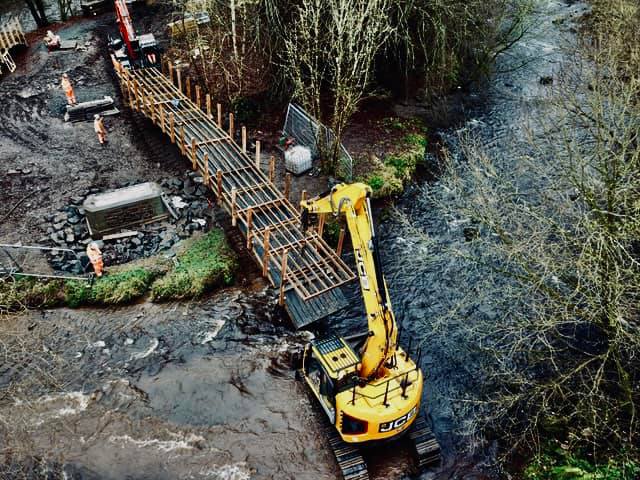
BEAVER Bridges’ build of a new crossing at Doune Castle has been hailed by Historic Environment Scotland as an ‘achievement worth celebrating’ after the company’s senior project manager revealed it was the ‘most complex’ of his career.
Adam Curtis led the firm, which has a base in Motherwell, in the offsite build and installation of the all-timber, double arch, glue and screw laminated architectural bridge structure at the 15th century site.
“The time of the year in which we were carrying out the works meant that the access was horrendous,” he told Project Scotland, before going on to explain how the strength of the crossing’s arch comes when its ends are locked into position – meaning the bridge had to be braced together on an HGV to prevent it springing apart en-route to the site.
“Due to the size of the load, we had to go through the castle side and up and over the burn,” he added. “We had to go tandem lift with two excavators on steel tracks to get across, whilst protecting tree roots and not damaging any habitats in the process – so quite tricky all round.”
Building the crossing at the site would have potentially presented problems, due to Scotland’s erratic weather conditions. Adam explained that components are glue laminated and as such the adhesives can only be used at certain temperatures. As a result, building it in a workshop helped to ensure the required temperature could be maintained.
“It’s hard to predict Scottish weather,” he said. “But that’s something that Beaver Bridges deals with quite well; we understand the complexity of Scottish weather and the severity – it’s something you can’t always directly plan for; you just have to ensure you have a plan A and plan B.”
The firm, which has carried out hundreds of bridge builds across the UK including in London, Brighton, Stirling, Glasgow and currently at Lossiemouth’s famous East Beach, is rich in Scottish heritage – with chief executive, Henry Beaver, and wife, Jo, hailing from the north of Scotland.
“We pride ourselves in our Scottish division,” Adam added. “Focusing on the Scottish market is a vital part of what we do at Beaver Bridges; it helps maintain that family business ethos, which is an important part of the company – and obviously you also get to see pleasant scenery and people in the process!”

Historic Environment Scotland made clear in the project brief that local larch be sourced from the Wood of Doune to be used to create the structure.
“That’s what excited us in particular with the project,” Adam explained. “That challenge of taking something which literally grows within the vicinity and turning it into a structure that’ll be there for many years to come.
“For me, bridging is all about solutions and finding an answer to problems. What our client is creating is not just a solution to get them from A to B, but also something that will become a focal piece.
“With the castle being as busy and popular as it is, this is a real focus point that thousands of people will cross – it’s not just a straightforward bridge with a parapet; you’ve got arches, a garden rail, different timber, oak and larch.”
To achieve the arches, the firm picked datum points off the architectural drawings using the design software AutoCAD, before fixing down the end plates in the workshop and then creating a scaffolding using the datum levels to make sure it was the right curvature, before finally building a timber scaffold to ensure the constant curve.
Adam said he anticipates an increasing demand for timber structures amidst the climate crisis. “You get different challenges with different materials,” he said. “There’s easier and harder points to both (timber and steel). With timber you get a lot more workability sometimes because it’s naturally easier to work with. Whilst with steel, it’s a lot sturdier and you can further span – each has its own complexities and its own rewards.
“I certainly anticipate an increase in demand for glulam laminated structures, and that’s something we will be pushing at Beaver Bridges as part of our portfolio – it gives you the strength that you need, but also looks impressive and can be resourced locally.”
Tapping into the local community is ‘key’ for the business, with local school pupils receiving construction-related education as part of the ongoing Lossiemouth bridge build and Historic Environment Scotland civil engineering students being brought on board during the abutment works at Doune, with the scholars checking all the formwork and steel against the bar bend schedule and design as part of their coursework.
“Something we really do drive at Beaver Bridges is that local community involvement,” Adam said. “It was also great seeing such a local interest in the project, which we really appreciated.”












